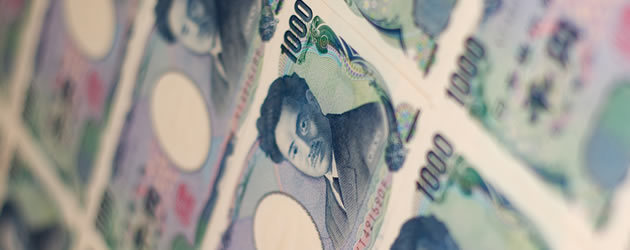
The Japanese Yen surged higher against all of the majors earlier this morning in reaction to a big miss for Japanese second quarter GDP. Disappointing expectations of 0.9% the quarterly growth figure came in at just 0.6%, whilst the annualised GDP print came in at 2.6%; significantly lower than forecasts of 3.6%. First quarter Japanese growth was also revised down from 1.0% to 0.9%.
Ordinarily, a weak GDP print of this nature would have a negative impact on the Japanese Yen because it would encourage the Bank of Japan to pump further stimulus into the domestic economy. Earlier this year the BoJ announced an unprecedentedly aggressive monetary easing scheme; the Central Bank plans to purchase close to $70 billion worth of assets every month in order to drive investment into the real economy and end the country’s 15-year stagflationary circle. It stands to reason that if Japanese GDP does not perform inline with the BoJ’s projections then the Japanese Central Bank will look to foster growth through enhanced monetary stimulus – something that is seen to devalue the domestic currency.
However, on this occasion the soft GDP report has been interpreted as bullish for the Yen because of a separate debate in Japan focussed around a proposed 3% sales tax hike. The Japanese national deficit is currently around two-and-a-half years worth of economic output – astonishingly high – and in order to help balance out the books the Bank of Japan intends to raise taxes. However, the decision hangs in the balance as fiscal consolidation of this nature is likely to harm Japanese growth and could potentially imperil the domestic revival.
BoJ Governor Haruhiko Kuroda has explicitly mentioned that the Q2 GDP figure will play a pivotal role in colouring the Bank’s decision on the matter; a miss of the magnitude witnessed this morning makes it fairly unlikely that the BoJ will risk impacting the economy with a steep tax hike. With Japanese GDP unlikely to suffer the hit that many analysts had pencilled in, demand for the Yen soared as stimulus expectations were scaled back.
In immediate reaction to the contrarily bullish disappointing GDP data the Japanese Yen advanced by around 0.35 cents against the US Dollar, the Euro, the Australian Dollar and the Canadian Dollar. The Yen also rallied by 0.2 cents against the New Zealand Dollar and 0.3 cents against the Pound Sterling.
In light of the undershooting second quarter growth figures the tax hike looks unlikely, however, the BoJ is not expected to make a decision until September when the revised GDP print is released. First estimate Japanese data releases are famously inaccurate – during the last five years the average difference between first and final GDP readings is a staggering 0.79% – and for this reason traders retained a sense of caution and did not invest with undue optimism in JPY. Having said that, the extent to which the GDP print missed economists’ expectations suggests that the BoJ will snub the proposed 3% tax hike in favour of a less aggressive 1% increase. Under this scenario JPY strength is likely to continue.

Comments are closed.